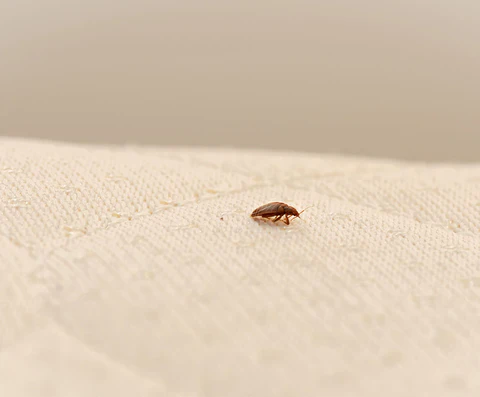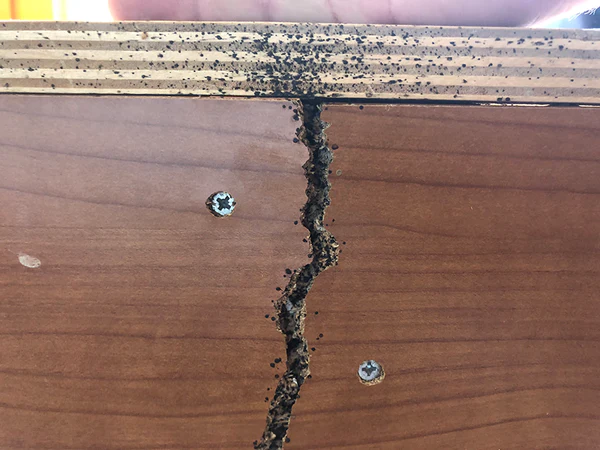The discount on Floor model mattresses is so lucrative that everyone eyes them. However, they are rarely purchased by consumers. One of the reasons is that these mattresses are prone to bed bug infestation.
So, can a floor model mattress have bed bugs?
A floor model mattress is highly likely to contain bed bugs. A bed bug can enter a mattress in a variety of ways, including customers, employees, or store items. Before purchasing a floor model mattress, you should look for signs of bed bug infestations.
After reading this article, you will realize are floor models mattresses worth it or not and how to deal with a bed bug problem.
Can A Floor Model Mattress Have Bed Bugs?
Floor model mattresses are especially vulnerable to bed bugs because they are handled and moved more frequently than stock mattresses. Bed bugs can infest a floor model mattress in several ways. For example-
- Infested Customer: When customers lie down on a floor model mattress to test it, they could potentially bring bed bugs with them, unknowingly.
- Infested employees: Bed bugs can also be brought into a store by employees who have bed bugs at home. If an infested employee handles a floor model mattress, they could potentially transfer bed bugs to the mattress.
- Infested items in the store: Bed bugs can also infest items that are already in the store, such as upholstered furniture, curtains, or carpets. If these items are infested with bed bugs, the bugs can crawl onto the floor model mattresses and infest them as well.
- During Transportation: Mattresses can be infested by bed bugs during transportation. Delivery trucks and vans can become infested with bed bugs, and if mattresses are stored in the same vehicle, the bed bugs can crawl onto the mattresses.
- Customer returns: When customers return mattresses, there is a risk that bed bugs could be present on the mattress. If the mattress is then put back on display as a floor model, the bed bugs could infest other mattresses in the store.
Bed bugs are excellent hitchhikers and it’s very easy for them to hang on to clothing, luggage, or any other items. Once inside the store, bed bugs can crawl into the seams and crevices of a floor-model mattress and hide until they find a new host to feed on.
To survive, bed bugs require warm, carbon dioxide-rich environments. That’s why the bugs are especially drawn to people who are sleeping on mattresses.

Should You Buy a Floor Model Mattress?
Yes, you should buy a floor model mattress, if you are looking for premium-quality mattresses for a cheap price. Floor model mattresses are priced much lower than stock mattresses. Discounts usually range from 50% to 70%. Also, if you can negotiate well, you can convince the dealer to give you free delivery.
But apart from these, there are a few pros and cons of buying a floor model mattress that you should look at.
Pros of Buying a Floor Model Mattress:
- Lower cost: Floor model mattresses are often sold at a discount because they have been used for display purposes. If you are on a tight budget, buying a floor model mattress can be a way to save money on a high-quality mattress.
- No waiting period: Some mattresses have a break-in period, during which time they need to be used before they become comfortable. Floor model mattresses have already been broken in, so you can get a good idea of how they will feel when you sleep on them.
- Free Delivery: While buying a floor model mattress, you can negotiate with the dealer for free delivery. Floor model mattresses are usually the last ones sold, so it’s highly likely the dealer won’t mind.
Apart from these, the material of the mattress foam is also important. For that, knowing the difference between a cold foam mattress and latex could contribute to your choice.
Cons of Buying a Floor Model Mattress:
- Wear and tear: Floor model mattresses have been used for display purposes, which means they may have more wear and tear than brand-new mattresses. The mattress might have a shorter lifespan because of this.
- Hygiene concerns: As we discussed earlier, floor model mattresses are more likely to be infested with bed bugs, and they may also harbor other germs and bacteria. While stores should have protocols in place to prevent and control bed bug infestations, there is always a risk of exposure when buying a floor-model mattress.
- No warranty, return, or refunds: Floor model mattresses may not come with a full warranty, or the warranty may be limited due to their display use.
Does Your Mattress Have Bed Bugs?
If you have chosen a floor model mattress or have already bought one, you must now be wondering “how to check my mattress for bed bugs”.
Well, first off, here are the symptoms you must look for if you suspect that your mattress has bed bugs-
- Visible bugs: If you see live (or dead) bed bugs around your mattress, it’s a clear sign of infestation. But, the question is, how do bed bugs look on mattresses?
In their adult form, bed bugs are approximately the size and shape of an apple seed and reddish-brown in color. If you see bugs crawling on your mattress or bed frame, it is a clear sign of an infestation.
Even if you do not see live bed bugs, you may find their shells or eggs near your mattress.

- Fecal stains: Bed bugs leave behind small black or brown stains on the mattress or bedding. These stains are feces and may be visible on the mattress, sheets, or pillowcases.

- Blood spots: When bed bugs feed, they leave behind small blood spots on the mattress or bedding. A bed bug infestation could be detected by rust-colored spots on your sheets.
- Musty odor: Bed bugs release pheromones that have a musty, sweet odor. If you notice an unusual odor on your mattress or bedding, it could be a sign of a bed bug infestation.
- Itchy skin: If you notice itchy areas of your body that weren’t there before you went to bed, it could be a sign of a bed bug infestation. Small red welts are typically the sign of bed bug bites and can be itchy or painful. They are often found in clusters or a straight line on areas of exposed skin. For example, the arms, legs, and face.

While bed bugs do not transmit diseases, their bites can lead to secondary infections from scratching the affected area.
Now that you know what to look for, here is the thorough process of how to check your bed for bed bugs–
- Remove all sheets, blankets, comforters, and pillowcases from your mattress. Look for bed bug feces or blood spots. Inspect the mattress top and seams.
- Make sure your mattress isn’t too close to the wall so you can see if there are bed bugs there. This also gives you more space to perform your inspection.
- Even if you don’t find any visible blood spots or fecal markings, check the mattress underneath. Carefully remove all bedding without shaking it so that bed bugs don’t get thrown around your bedroom.
- Wear gloves for protection as you inspect the seams and folds of the mattress. When the bedbugs or their eggs, or skin casings, are tucked deeper inside the seams of the mattress, you can use a card to lift them out.
- Lean the mattress against a wall so that you can examine the underside of it. Flip the mattress over. It’s a good idea to check the same areas as the top, as well as the corners and seams, paying particular attention to them.
- Inspect your box spring if you have one after moving the mattress off the bed frame. Make sure there are no spots along the seams and folds of the mattress. Ensure the dust cover on the bottom of the box spring is also flippable since bed bugs can also be found crawling around there.
- You should also make sure that the bed frame that you are using is in good condition. Bed bugs can hide inside small screw holes, cracks, and crevices.
- As a final resort, you can consider getting a canine bed bug inspection if you have not been successful in finding bed bugs on your own. These specially-trained dogs have a 96% accuracy rate in detecting live bed bugs, eggs, and casings that the human eye may miss.
Even after following these steps, if you have not found any bed bugs, you can rest assured that your mattress does not have any bed bugs.
How Do You Deal With Bed Bugs Found in Your Mattress?
If you do find signs of a bed bug infestation, it’s good news for you. Because now you can follow the steps below to permanently get rid of them-
Clean All Your Bedding:
Remove all bedding including pillows, pillowcases, sheets, and anything else that could be harboring bed bugs. Take these items to your laundry room or laundromat by putting them in a trash bag.
Use hot water to wash them, and dry them on the highest setting in your dryer. Avoid using your regular laundry basket to move your bedding as bed bugs can cling onto it and infest other areas in your home.
Vacuum Thoroughly and More Than Once:
Vacuum your bedroom, focusing on areas around your bed, bed frame, and other furniture. Use the hose attachment instead of the brush attachment to avoid pushing bed bugs further into the crevices.
Pay special attention to the small crevices in your mattress and other furniture, and repeat the vacuuming process several times. Dispose of the vacuum’s contents in an outside garbage can and clean the container to prevent any bed bugs from escaping.
Disassemble Your Bed Frame:
It’s best to remove your bed frame and clean every inch of it. There are countless places where bed bugs can hide, so it is worth taking the time to rid your home or business of them.
Make sure that you look closely at the crevices using a magnifying glass and a flashlight. You can prevent bed bugs from hiding in your wooden bed frame by sealing any cracks.
Use Safe Insecticides:
Now, this is the fun part. You must already know you are gonna have to kill the insects. So, what instantly kills bed bugs?
For instant killing of bed bugs and their eggs, the best thing to use is steam. Temperature is the number one enemy of bed bugs. So, steam, which has a temperature of 100 degrees Celsius will instantly kill bed bugs. Also, this is a more sustainable solution, as it is safe to use instead of chemical insecticides.
If you have a steamer at home, use it to steam your mattress to get rid of bed bugs. It is recommended to use this method along with other techniques in order to get the best results. You will need at least 50 degrees Celsius (122 degrees Fahrenheit) to kill bed bugs.
Apart from steam, you can also use a couple of other cooking ingredients, like baking soda, cayenne pepper, etc to kill bed bugs easily.
Cover Your Mattress And Box Spring:
Consider purchasing a special mattress and box spring cover to encase your mattress and box spring. These covers make it virtually impossible for bed bugs to escape and are an effective way to protect your mattress from bed bugs.
You should leave the covers on for at least a year to discourage bed bugs from reproducing. There’s no point in trying this method if your bed frames, nightstands, or anywhere else in the room has bed bugs.
How to Keep Bed Bugs Away From Your Mattress?
It’s even better news if you do not have a bed bug infestation on your mattress. On top of that, if you never want to deal with this nuisance, you can prevent it by doing the following-
- Reduce your junk: Bed bugs like to hide in messy places, so tidying up your home can reduce their hiding spots and make them easier to detect.
- Clean your home regularly: Bed bugs can hide in cracks and crevices, so it’s important to regularly dust and scrub areas such as baseboards, mattress seams, and box springs to keep them from hiding there.
- Keep an eye out: If you’ve had bed bugs before, you’ll want to keep an eye out for any signs of them returning. Look for the common signs we have mentioned before.
- Invest in a mattress protector: A mattress protector can help prevent bed bugs from getting into your mattress, and can also help prevent allergens and dust mites.
- Inspect second-hand mattresses before purchase: Second-hand furniture and mattresses are common sources of bed bugs, so it’s best to avoid them if possible. If you do bring them home, inspect them thoroughly and clean them outside if possible.
Frequently Asked Questions (FAQs):
How long can bed bugs live on a mattress?
Bed bugs live in mattresses for months at a time. Although they feed every 3 to 7 days, they can go without food for up to 6 months at a time. They lie dormant and consume very little energy as they wait for humans or animals to return to their domain.
Is it OK to sleep with bed bugs?
No, but you should not switch rooms after you have seen signs of a bed bug infestation. By switching rooms or beds, you risk infesting the other room or the bed by using it.
Do bed bugs go in your ears?
Yes, bed bugs can technically enter your ears, but it is very rare and unlikely. Bed bugs feed on blood by piercing the skin, and they do not need to enter the body to access their food source. It is much more common for bed bugs to hide in bedding, mattresses, furniture, and clothing.
Conclusion
So, can a floor model mattress have bed bugs? Yes, it definitely can. So, avoid buying floor model mattresses unless you have to. And when you do buy one, check it thoroughly before buying. Also, if possible, steam before using it.




![Espresso Puck Stuck To Grouphead [5 Reasons & Easy Solutions] Espresso Puck Stuck To Grouphead [5 Reasons & Easy Solutions]](https://reviewnery.com/wp-content/uploads/2023/03/espresso-puck-stuck-to-grouphead-211x150.webp)

![Why Is Espresso Too Acidic [5 Reasons To Solve!] Why Is Espresso Too Acidic [5 Reasons To Solve!]](https://reviewnery.com/wp-content/uploads/2023/03/espresso-too-acidic-211x150.webp)